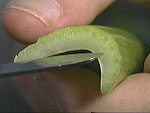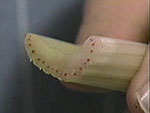Plant Parts
| Helpful terms Herbaceous:
Plants with stems that are usually soft and bendable. Herbaceous stems die back to the ground every year.
Woody:
Plants with stems, such as tree trunks, that are hard and do not bend easily. Woody stems usually don't die back to the ground each year.
Photosynthesis:
A process by which a plant produces its food using energy from sunlight, carbon dioxide from the air,
and water and nutrients from the soil.
Pollination:
The movement of pollen from one plant to another. Pollination is necessary for seeds to form
in flowering plants.
What's the difference between a fruit and a vegetable?
A fruit is what a flower becomes after it is pollinated. The seeds for
the plant are inside the fruit.
Vegetables are other plant parts. Carrots are roots. Asparagus stalks are stems. Lettuce is leaves.
Foods we often call vegetables when cooking are really fruits because they contain seeds inside.
Play a Plant Parts Game!

|
 What Do Different Plant Parts Do? What Do Different Plant Parts Do?
Plant parts do different things for the plant.
Roots
Roots act like straws absorbing water and minerals from the soil. Tiny root hairs stick out of the root, helping in the absorption. Roots help to anchor the plant in the soil so it does not fall over. Roots also
store extra food for future use.
Stems
Stems do many things. They support the plant. They act like the plant's plumbing system, conducting water and nutrients from the roots and food in the form of glucose from the leaves to other plant parts. Stems can be herbaceous like the bendable stem of a daisy or woody like the trunk of an oak tree.
 |
 |
 |
| A celery stalk, the part of celery that we eat, is a special part of the leaf structure called a petiole. A petiole is a small stalk attaching the leaf blade of a plant to the stem. |
In celery, the petiole serves many of the same functions as a stem. It's easy to see the "pipes" that conduct water and nutrients in a stalk of celery. |
Here the "pipes" are dyed red
so you can easily see them. |
Leaves
Most plants' food is made in their leaves. Leaves are designed to capture sunlight which the plant uses
to make food through a process called photosynthesis.
Flowers
Flowers are the reproductive part of most plants. Flowers contain pollen and tiny eggs called ovules. After pollination of the flower and fertilization of the ovule, the ovule develops into a fruit.
Fruit
Fruit provides a covering for seeds. Fruit can be fleshy like an apple or hard like a nut.
Seeds
Seeds contain new plants. Seeds form in fruit.
|







 What Do Different Plant Parts Do?
What Do Different Plant Parts Do?